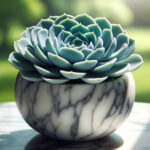An Introduction to the Fascinating Echeveria Runyonii
For succulent enthusiasts, hobbyist gardeners, and horticulturists alike, the Echeveria Runyonii holds a special place. This unique plant, with its rosette-shaped leaves and intriguing gray-green color, is one that’s sure to captivate anyone who catches a glimpse of it.
Origins of the Echeveria Runyonii
The Echeveria Runyonii traces its origins to Mexico, specifically to the rocky terrains of the Tamaulipas area. This sturdy plant thrives in those tough conditions, demonstrating its amazing resilience and ability to weather harsh environments with grace. This background not only speaks to its hardiness but also makes it a wonderful choice for gardeners looking for a sturdy, hassle-free plant or those simply in love with succulents.
What Makes the Echeveria Runyonii Unique?
Despite its rugged origins, the Echeveria Runyonii, often lovingly referred to as the “Topsy Turvy,” flaunts an unparalleled beauty. The leaves curve inwards, giving the plant a swirling, symmetrical appearance, often described as mesmerizing. This aesthetic, combined with its sturdy nature, makes the Echeveria Runyonii a truly distinctive addition to any garden or home interior decor.
Echeveria Runyonii: The Gardener’s Favourite
There’s a reason Echeveria Runyonii garners such a large following among gardening circles. Beyond their beauty and resilience, they’re easy to care for, making them perfect for both expert and novice gardeners. With minimal maintenance and their capabilities to thrive in varying conditions, these plants provide a sense of accomplishment, making them a beloved feature in many gardens globally.
Whether you’re a seasoned horticulturist searching for a new, intriguing plant to grace your landscape, or a budding gardener looking for a hassle-free plant to start your journey, the Echeveria Runyonii may be the ideal choice. After all, its unique appearance, strong roots, and easy upkeep are just a few of the traits that make this succulent a crowd favorite.
An In-Depth Look at Echeveria Runyonii’s Physical Characteristics
When you first lay your eyes on an Echeveria Runyonii, you’ll instantly be captivated by its alluring aesthetic. Sure, we could get into the nitty-gritty scientific jargon, but let’s bring it down to earth with a more relatable description. Think of it as a mesmerizing cross pattern that Mother Nature delicately crafted using paint or a crochet hook.
Echeveria Runyonii’s Color Palette
The Echeveria Runyonii is best described as an elegant canvas boasting an array of pastel hues. The predominant color is a soft, calming green, reminiscent of the first shoots of spring. As you move towards the tips of the leaves, the green subtly blends into a soft blue, bringing to mind serene azure skies on a warm summer day.
And just when you think the aesthetic journey ends there, peachy pink highlights grace the leaf margins and tips, adding an unexpected yet delightful contrast. It’s as if each leaf dipped its tips in the rosy hues of a dreamy sunset. Taken together, these shades make Echeveria Runyonii an absolute pleasure to behold.
Size and Growth Pattern of Echeveria Runyonii
Size-wise, Echeveria Runyonii is a modest, humble specimen. This petite succulent can grow up to four to eight inches in diameter, making it an ideal desktop companion or windowsill decoration. Its stature may be small, but the personality and charm it exudes are quite the opposite – proof that great things, indeed, come in small packages!
As for mature plants, they tend to grow small offsets that surround the mother plant. Imagine this as having your own tiny green village brimming with gravitational charm, all contained in a single pot. Quite the conversation starter, isn’t it?
Echeveria Runyonii’s Distinctive Rosette Shape
Perhaps the most distinctive feature of the Echeveria Runyonii is its enchanting rosette shape. This isn’t any ordinary rosette, though. The leaves are plump and meaty, curving upwards to form a slightly dome-shaped rosette. We’re talking about a botanical sculpture that rotates in symmetry – a hypnotic spiral made of fleshy, pastel leaflets.
It’s the perfect blend of elegance and geometry which creates a uniquely enchanting visual rhythm. Whether you’re a succulent newbie or a seasoned collector, Echeveria Runyonii won’t fail to make its mark with its remarkable physical characteristics.
Now that we’ve covered the basics of Echeveria Runyonii, it’s time to dive into some of the popular variations of this stunning succulent. This will help you pick the perfect one for your home or garden, each providing a unique touch of natural charm.
Exploring the exciting world of Echeveria Runyonii Varieties
Understanding the differences between the various Echeveria Runyonii varieties can help you make the right choice for your space. Trust us, there’s an incredible array of these lovely succulents, and each one has its own special charm.
The Classic ‘Topsy Turvy’
The classic Echeveria runyonii ‘Topsy Turvy’ is definitely a crowd favorite. It’s one of the most iconic varieties of this plant. Topsy Turvy is easily recognizable with its grayish-blue leaves that curve towards the center, giving it its distinctive rosette shape. The leaves take an interesting ‘U’ shape – a defining characteristic of this variety.
Stunning ‘Silver Spoons’
Next up, meet the ‘Silver Spoons’, another variety of the wonderful Echeveria runyonii world. Silver Spoons is aptly named for its spoon-shaped leaves, which add a striking dimension to any garden or indoor arrangement. The leaves are powdery silver-blue, providing a cool and classy touch to any green space.
Echeveria Runyonii ‘Snow Bunny’
The Echeveria runyonii ‘Snow Bunny’ is sure to melt your heart with its adorable appearance. This variety stands out with its smaller, more compact size and the slight pinkish hue on the edges of its spoon-like leaves. As the ‘Snow Bunny’ matures, the pink becomes more noticeable, turning this adorable plant into a real eyecatcher.
Identifying Echeveria Runyonii Varieties
While these all belong to the Echeveria runyonii family, they have distinct differences. ‘Topsy Turvy’ is identified by its inverted leaf structure, ‘Silver Spoons’ catches the eye with its signature spoon-shaped leaves, and the ‘Snow Bunny’ dazzles with its pink-tinted edges. They might share the same genes, but each proudly boasts its own unique identity.
Knowing these differences is important if you’re planning on growing different Echeveria runyonii varieties. Not only will you be able to identify what you have in your garden, but it’ll also help you provide the best possible care for your plants. Remember, each variety might demand slightly different care practices to flourish.
Whether you’re a novice or a seasoned plant parent, understanding these distinct varieties of Echeveria runyonii can offer a satisfying and rewarding gardening experience. Ready to welcome these captivating succulents into your green realm?
Embarking on the Journey of Growing an Echeveria Runyonii
Imagine waking up to the sight of a vibrant, beautifully shaped succulent that you’ve cultivated yourself. This isn’t just any succulent though, it’s the uniquely charming Echeveria Runyonii. Cultivating this dazzling plant may seem daunting, but rest easy, it’s a surprisingly straightforward process that turns anyone into a green thumb guru.
Understanding Your Echeveria Runyonii’s Ideal Growing Conditions
First off, let’s delve into the conditions where your Echeveria Runyonii will really thrive. Picture a warm, sunny landscape, because this beauty is in fact a desert native! It adores summer heat and a bit of sunbathing, but won’t say no to getting cozy indoors during colder months.
Time to Talk Soil Type
Now, as for the soil, remember how we described Echeveria Runyonii as a desert dweller? Well, this isn’t a plant that enjoys being water-logged! So, a good quality succulent or cactus mix is your best bet. Think of something well-draining and, of course, nutrient-rich. If you can’t find an ideal mix, aim to create your own by combining potting soil, coarse sand, and perlite or pumice – a surefire way of giving your Echeveria Runyonii a comfortable new home.
Finding the Perfect Sunny Spot
A great way to keep your Echeveria Runyonii feeling at home is to ensure that it is exposed to plenty of sunlight. These succulents love a good 6 hours of daylight. It’s like giving them a dose of their ancestral desert homeland. If indoors, position your plant in a place with lots of natural light, but remember, direct, intense sunlight might cause its leaves to get sunburned – and no one wants that!
Getting the Watering Practice Just Right
Finally, let’s discuss watering. Watering your Echeveria Runyonii isn’t about constant hydration, but rather, holding back until it’s just the right moment, much like waiting for the perfect moment to transpose the sentiments of your heart onto paper. Stick to the ‘soak and dry’ method here. Essentially, wait until the soil is completely dry before giving it a hearty drink. And remember, overwatering is an all-too-easy mistake to make, and it’s one your Echeveria Runyonii will not thank you for.
There you have it, a comprehensive guide on cultivating your own regal Echeveria Runyonii. It’s a journey with some twists and turns, yes, but it’s also an enticing window into the green-thumbed world of botanical nurturing. With a little patience, a splash of love, and by following these golden rules, you’ll soon be living with a thriving, vibrant Echeveria Runyonii of your own.
If you’re a fan of succulents, you’re going to love Echeveria Runyonii. Also known as ‘Topsy Turvy,’ this beauty is known for its rosette form and icy-blue leaves that curve upward. But how do you care for it? Here’s everything you need to know.
Caring for Your Echeveria Runyonii
Caring for your Echeveria Runyonii isn’t as hard as it sounds. These plants are quite resilient and can handle a variety of conditions.
Pruning
Let’s start with pruning. You see, Echeveria Runyonii doesn’t require a lot of pruning. In fact, most of the time, you will only need to remove dead leaves to prevent diseases and pests. However, if the plant becomes too large for its container, you might have to snip off a few leaves or stems. Remember, always use a sharp, clean tool to avoid inflicting damage.
Frost Protection
Now, let’s talk about frost – a succulent’s worst enemy. If you live in a colder region, ensure your Echeveria Runyonii is immune to frosty winters. During frost, the water inside their cells can freeze, causing serious damage and even killing the plant. So, it’s crucial to bring these beauties indoors and provide a warm place for them to hibernate.
Fertilization
Next up is fertilization. Is it necessary? Well, yes and no. While Echeveria Runyonii doesn’t need a lot of fertilizer, a little boost during the growth season (spring and summer) can do wonders. Choose a fertilizer suitable for cacti and succulents. Remember to follow the package instructions and never over-fertilize; less is more with these plants.
Repotting
Talk about re-potting, your Echeveria Runyonii will appreciate a new home every two or so years. This will give it more space to grow and reinvigorate its soil. Choose a pot that’s slightly bigger than the old one. And remember to use a cactus mix or a soil mix that drains well, as these plants don’t do well in soggy soil.
Common Pests and Diseases
Finally, let’s touch on common pests and diseases. The most common enemies of Echeveria Runyonii include mealybugs, aphids, and black spots cause by overwatering or exposure to cold temperatures. If you notice any odd spots or insects, act fast. Treat infestations with a mild insecticide or a spray of water and mild dish soap. For fungal diseases, adjust your watering schedule or consider changing the environment.
And there you have it – your guide on caring for the delightful Echeveria Runyonii. Remember, this plant doesn’t ask for much: just a bit of pruning, a friendly spot away from frost, occasional fertilizer, and an on-schedule re-potting. Stick to these guidelines, and your Echeveria Runyonii will thank you with its stunning aesthetic appeal!
When it comes to propagating your Echeveria Runyonii, also fondly known as the Topsy Turvy succulent because of its uniquely contorted leaves, we’ve got you covered. Let’s dive into the specifics!
Leaf Cuttings
Propagating the Echeveria Runyonii from leaf cuttings couldn’t be simpler. You start by gently twisting a leaf from the stem. It’s crucial that it’s a clean pull, leaving nothing on the stem. Now, call me crazy, but I like to imagine I’m undoing a button; gentle but firm.
Then comes the waiting game. Let your leaf dry in a shady spot away from direct sunlight for about a week, or until it has completely dried and calloused over. Once it’s calloused, place it on well-draining cactus or succulent soil, sprayed slightly with water. Soon enough, you’ll witness the magic that is propagation, delivered by mother nature herself.
Stem Cuttings
One November, I decided to experiment with stem cuttings from my Echeveria Runyonii, and boy was it rewarding! It requires a bit of finesse, but once you get the hang of it, it’s pretty straightforward. Use a sterile knife to cut a healthy stem from your plant. Give it the same callousing treatment explained before, and once it’s ready, plant it about an inch deep into the cactus mix.
The roots should start taking shape after a month. For quicker results, it’s best to do this in the warm season when the plant is naturally inclined to grow.
From Seeds
If you fancy more of a challenge and are ready to exercise some patience, growing the Echeveria Runyonii from seeds could be the project for you. It may take longer, but witnessing those tiny sprouts push through the soil for the first time is one of the most rewarding experiences for any plant lover!
Start off by purchasing Echeveria Runyonii seeds (remember, your local online plant store is your best friend). Sow them shallowly in a tray filled with a well-drained cactus mix. Moisture is essential, but don’t drown those tiny seeds. A spritz or two a day should suffice. Keep them in a warm, bright place, but out of full sun until they begin to germinate.
The Best Season for Propagation
Spring and summer are your best friends when you are on a mission to propagate your Topsy Turvy. Given the Echeveria Runyonii is a warm-weather-loving plant, these seasons provide the ideal growth conditions. Expect your propagation efforts to pay off quicker during these periods.
The excitement of watching your new little Echeveria Runyonii come to life truly is a joy! So, whether you choose leaf cuttings, stem cuttings or the patience-testing route of seeds, we cannot wait for you to share your successful propagation stories. Happy gardening!
Landscaping with Echeveria Runyonii:
So, you’ve got your hands on an enchanting Echeveria Runyonii, also known as Topsy Turvy. Well, you’re in luck, because this spiraling succulent can jazz up any setting, whether it’s an outdoor garden or a cozy indoor space. But some of us are left wondering – how exactly do we fit Echeveria Runyonii into our current setting?
Empowering Your Outdoor Landscape with Echeveria Runyonii:
Picture your outdoor garden, all that open space ready to be transformed into a magical haven. If you plant your Echeveria Runyonii out in the open, they will not only thrive, but also add a natural artistic touch. Their stunning rosettes and silvery-blue leaves can provide a delightful contrast to your otherwise green garden.
Think of Echeveria Runyonii as the stars of your garden. Let your other plants play the supporting characters. Complement them with plants that share similar growth and care needs. Several succulents like Graptoveria ‘Fred Ives’ or Sedum ‘Blue Spruce’ pair well with Echeveria Runyonii, forming a compatible and eye-catching grouping.
Adding a Splash of Aesthetic to Your Indoor Spaces:
Although outdoor scenery is enchanting, not all of us have that luxury. But have no fear, Echeveria Runyonii is here to take your indoor spaces to another level. This succulent’s exceptional design and minimal care requirements make it an ideal [decorative piece] around your home or office.
Imagine placing an attractive pot of Echeveria Runyonii on your windowsill. It’s not just a plant; it’s an art installment. Its design is so symmetrical and captivating that it’s bound to be a conversation starter. And the best part? Even if you don’t have a green thumb, you can manage to keep this resilient succulent alive and flourishing.
Try pairing your Echeveria Runyonii with other indoor plants like Spider plants or Pothos. Create a succulent display by adding different varieties of Echeveria for a harmonious, visually stimulating arrangement. Or, create a rustic look by placing this succulent in an aged terracotta pot; the combination of vibrant succulent leaves and the weathered pot can add a striking burst of nature to your interior design.
Breathe life into your spaces, both outdoor and indoor, with Echeveria Runyonii. This versatile succulent offers unlimited possibilities in transforming your garden or room into an aesthetic space brimming with nature’s charm. So go on, spice up your environment with the irresistible allure of the Echeveria Runyonii. You’ll be amazed at the transformative impact it has.
FAQs on Echeveria Runyonii
Arm yourself with answers to the most frequently asked questions about the captivating Echeveria Runyonii. Whether you’re a seasoned gardener or a beginner succulent enthusiast, we’ve got you covered!
How Can I Nurse a Dying Echeveria Runyonii Back to Health?
It’s purposeful to note that the resilient Echeveria Runyonii can bounce back from the brink of death! Scrutinize your plant and remove any yellow, brown, or dried-out leaves as they may infect healthy ones. Next, check if it’s overwatered or underwatered. If it’s the former, repot the plant in dry, well-draining soil and consider using pots with better drainage. If it’s the latter, treat your Echeveria Runyonii to a good soak of water. Remember, consistency is key in taking care of these gorgeous succulents!
What are the Signs of Overwatering?
Excess love in the form of water can be harmful to your Echeveria Runyonii! If your plant has been overwatered, you may notice; yellow leaves, mushy, translucent stems, and falling leaves are telltale signs of overwatering. To correct this, cut back on hydration and ensure your plant gets plenty of sunlight. Just think of your succulent as that friend who loves solo space!
Differences Between Echeveria Runyonii and Other Echeveria Species?
Caught mixing up your Echeveria Runyonii with her sister species? Well, the Echeveria Runyonii, also called Topsy Turvy, stands out with its distinct silvery, blue-gray, and uniquely shaped leaves that curl downwards. Unlike other Echeveria species, the Runyonii shows off its captivating appeal with large, bright orange and yellow bell-shaped flowers during the fall season. Now you won’t mistake your Runyonii for any other!
Where Are the Best Places to Purchase Echeveria Runyonii?
Ready to welcome an Echeveria Runyonii into your home or add another to your collection? There are plenty of places where you can find these beauties! Check out local gardening centers, or take your search online. Websites like Amazon, Etsy, and specialized succulent nurseries offer a wide variety of healthy, high-quality Echeveria Runyonii plants and seeds. However, before making a purchase, be sure to do a quick vet on the seller’s reputation and check out customer reviews. You know, a little homework for your future leafy friend!



